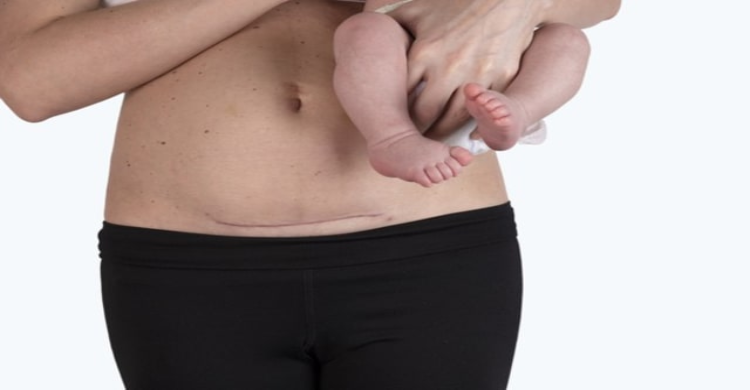Cesarean Section
What is a Caesarean Section?
A baby is delivered through Caesarean Section (C-Section) through incisions created during surgery in the abdomen and uterus. They are carried out when a vaginal birth is neither feasible nor safe or when your or your baby’s health is in jeopardy. Women who have previously undergone a C-section may do it again. But frequently, the need for a first-time C- section isn’t apparent until labor has begun.

Why a C-Section?
There are cases when a caesarean is planned early in a pregnancy, and women sometimes choose a C-section over a normal or vaginal delivery but most cases are unplanned, and surgery is opted for due to labour complications such as:
A C-Section is recommended by the doctor in the following events:
- One of the most frequent causes of a C-section is labour that isn't advancing (labour dystocia). Prolonged first stage (prolonged cervix dilatation or opening) or second stage problems might affect how labour progresses (prolonged time of pushing after complete cervical dilation).
- High Risk Pregnancies
- A C-section may be the most secure procedure if there are concerns about changes in the baby's heartbeat.
- The need for a C-section may result from a huge fibroid obstructing the delivery canal, a pelvic fracture, or a new born with a disease called severe hydrocephalus, which can result in an abnormally large head size.
- The safest method of delivery for infants whose shoulders or sides arrive first or whose feet or buttocks enter the birth canal first is a C-section.
- If a woman is expecting twins, triplets, or more, a C-section can be necessary. This is particularly necessary if labour begins too soon if the infants are not lying head-down.
- A C-section is advised for delivery if the placenta blocks the cervix's opening (placenta previa).
- If you've previously undergone a C-section or other uterine surgery. A doctor may advise a repeat C-section even though it's frequently possible to give birth vaginally following a C-section.
- If the umbilical cord loop passes through the cervix in front of the infant, a C-section may be advised.
- Women with specific medical conditions, such as a heart or brain disorder, may be advised to have a C-section.
How to prepare for a C-section?
If there are medical issues that might raise the risk of anaesthetic difficulties for a scheduled C-section, a healthcare professional will advise speaking with an anaesthesiologist. Additionally, a doctor may advise a few blood tests prior to a C-section. These tests reveal blood type and the amount of the primary component of red blood cells, among other things. In the event that you require a blood transfusion during the C-section, the test findings may be useful. Before your due date, talk with your doctor about the potential of a C-section.
How is a C-section performed?
You will be given anaesthesia before a C-section. An antibiotic will be used to clean your belly, and an oxygen mask may be put over your mouth and nose to help your baby get more oxygen. After that, the obstetrician will cut through your skin and into the abdominal wall. Your healthcare professional will next make a 3- to 4-inch incision in the uterine wall. Finally, your baby is extracted via the incisions by the doctor. The placenta is removed, the umbilical cord is severed, and the wounds are stitched and stapled together.
What happens after a C-section?
A C-section often necessitates a two- to three-day hospital stay. Options for pain management will be discussed with you. You’ll be advised to consume water and walk after the anaesthetic starts to wear off. Deep vein thrombosis and constipation are prevented as a result. Your incision will be watched by your medical team for indications of infection. Most likely, the bladder catheter will be taken out as soon as feasible. Even in the birth room, you can begin breastfeeding as soon as you’re ready. To learn how to support your baby and arrange yourself so that you are comfortable, ask your nurse or a lactation consultant. The medicines your medical team chooses for your post-surgical discomfort will take breastfeeding considerations into account.
Vaginal birth After Caesarean (VBAC)
Vaginal birth After Caesarean can be successfully attempted. Several women with a primary C-section (C-section in the first pregnancy) can consider VBAC as an option. Before advicing VBAC the history and clinical features of to-be mums is concidered. The incidence of scar ruptures during labour in VBAC is 0.1 to 0.5 per cent, which means 99.5 per cent of women undergoing VBAC may not have any complication. VBAC is universally accepted safe procedure which contributes immensely in bringing down the C-section rates.
How long does it take to recover?
It might take anywhere from four to six weeks to fully recover. The majority of medical professionals advise abstaining from stairs, lifting, vigorous activity, and other activities for many weeks. For up to six weeks, you might experience cramps, bleeding, and some discomfort near the incision. For discomfort, taking over-the-counter painkillers may be beneficial. For at least six weeks—or until your doctor gives the all-clear—avoid having any sexual activity.
What are the advantages of a C-section?
Depending on the stage of your pregnancy, a C-section has different benefits. The fact that a C-section is generally safer for both you and your baby is its main advantage. Most medical professionals will opt for a C-section to reduce risks when a vaginal birth is dangerous or might harm your baby. Unplanned C-sections do occur occasionally.
You shouldn’t experience any discomfort during a D&C since you’re will be under anesthesia.
Consulting hospital
Women's Care Clinic
- C/O Dr. Sonal Bhangale, SHOP NO 512, OPD 209, plot no 47, D Mart Rd, Sector 15, Kharghar, Navi Mumbai, Maharashtra 410210
Alpha One Hospital
- Alphaone Hospital, Kharghar 410210.
